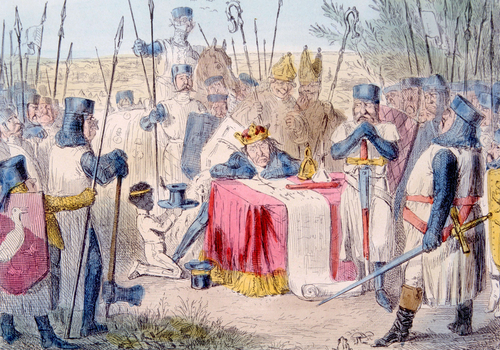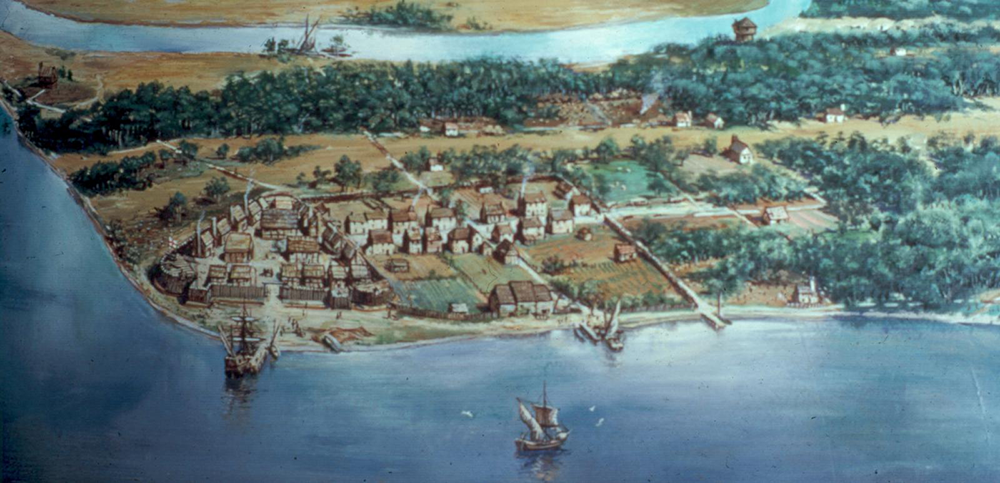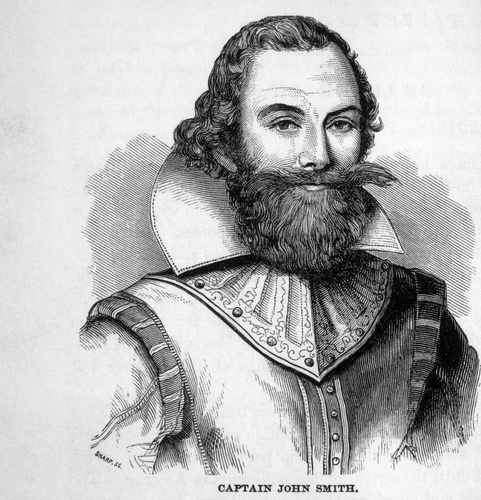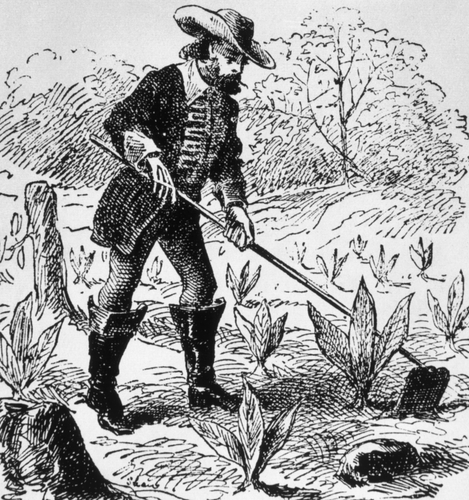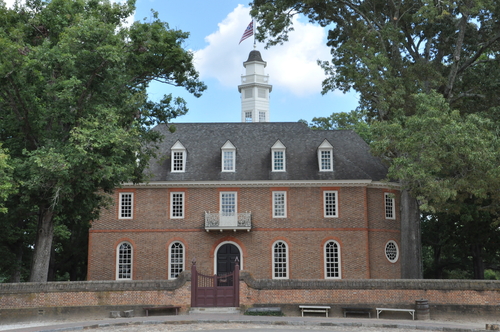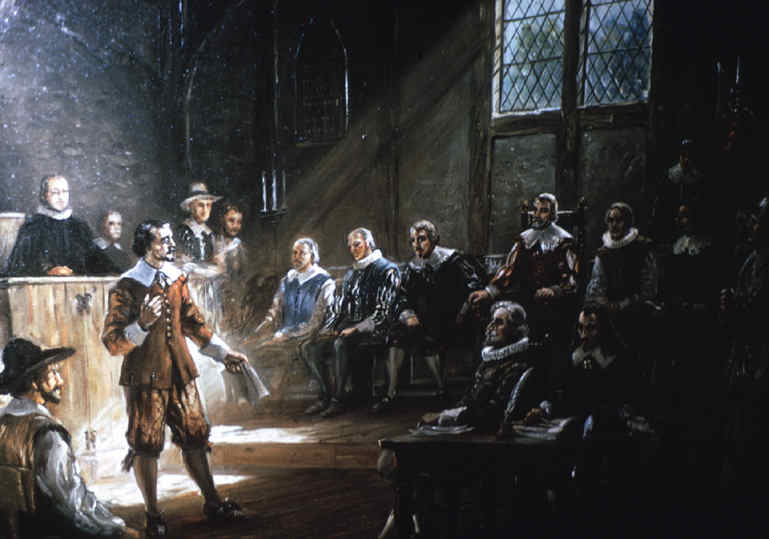
A scene from the House of Burgesses.
A student council is a group elected by students to represent the interests of kids in a school. In Jamestown, Virginia, the House of Burgesses was a group of lawmakers elected by residents of Virginia to represent settlers' interests. A burgess was a delegate to one of the divisions of a legislature which was created in 1619. Legislatures make law. Because each of the 11 Virginia settlements was entitled to elect two burgesses, the original membership of the House of Burgesses was 22.
The people of Virginia, being from England, were used to having a say in the way they were ruled because England had a constitutional monarchy (this means that although a king or queen was in charge, people still had some say in government.) Even though Jamestown answered to the English king, they needed a form of rules and regulations that made sense for their colony. The tradition established by the House of Burgesses was extremely important to colonial development. In turn, each new English colony demanded its own legislature.
This illustration by John Leech, published in 1875, shows the Magna Carta being signed by King John. The English colonies were able to practice democracy from an early time through the House of Burgesses, which would inspire similar chambers throughout the other colonies. However, the idea of representative government came from England itself. As English subjects, or citizens under the rule of the King of England, colonists were very familiar with their rights. England, unlike other European nations, was and still is a constitutional monarchy. That means that the English monarchs are restricted in what they can and cannot do. In other nations, like Spain and France, monarchs were absolute, meaning they held all control. The English kings and queens have exercised varying levels of authority – some were much more controlling than others. However, limits existed because of a document from 1215 C.E. called the Magna Carta, or “Great Charter”. In it, King John was forced by his nobles and the bishops to limit his power and guarantee certain rights to the nobles, such as innocent until proven guilty and trial by jury. In later editions, this would extend to all subjects, and eventually lead to the creation of Parliament, a bicameral national legislature that made laws. More rights would come through additional acts and decisions. This would be the basis of the House of Burgesses, a model colonial legislature based in Jamestown Colony, later to be known as Virginia. However, to understand how the House of Burgesses came about, the history of Jamestown and Virginia have to be revealed. An artist's depiction of Jamestown, Virginia, in 1614 A group of merchants, the Virginia Company of London, received a charter to settle a section of the Atlantic Coast of America named Virginia, in honor of Queen Elizabeth I, who never married nor had children. The Virginia Company was a joint-stock company where investors bought stock, or part ownership, in the company in return for a share of its future profits. The company acted quickly. In December 1606, it sent 144 settlers in 3 ships to build a new colony in North America. The settlers were supposed to look for gold and attempt to establish trade in fish and furs. Forty of them died during the voyage. In April 1607, the ships entered Chesapeake Bay and then sailed up a river flowing into the bay. The colonists named the river the James and their new settlement Jamestown to honor King James I, who had taken over England after the death of his cousin Elizabeth. The settlers built Jamestown on a peninsula so they could defend it from attack. The site had major drawbacks, however. The swampy land swarmed with mosquitoes that carried disease. Jamestown also lacked good farmland. The colonists faced more hardships over the next several months. Many of them were not accustomed to hard labor. Because the London investors expected a quick profit from their colony, the settlers searched for gold and silver when they should have been growing food. In addition, disease and hunger took a huge toll on the colonists. By spring 1608, when ships arrived with supplies and more settlers, only 38 of the Jamestown colonists remained alive. Captain John Smith (ca. 1580-1631) Governing Jamestown was perhaps the biggest obstacle the colonists faced. The colony survived its first two years because of 27-year old Captain John Smith, an experienced soldier and explorer. Smith forced the settlers to work, explored the area, and managed to get corn from the local Native Americans led by Chief Powhatan. In August 1609, 400 new settlers arrived. Two months later, John Smith returned to England. Without strong leadership, the colony could not feed so many people. The winter of 1609–1610 became known as “the starving time.” Fighting broke out with the Native Americans. When more settlers arrived in the spring, they found only 60 survivors. John Rolfe (1585-1622), a Jamestown, Virginia, colonist known for introducing the cultivation of tobacco in 1612 Although the Virginia colonists did not find any gold or silver, they did discover another way to make money for the investors. One colonist, John Rolfe, learned to grow a type of tobacco using seeds from the West Indies. The first crop was sold in England in 1614. Soon planters all along the James River were raising tobacco, and the colony of Virginia began to prosper and grow. Relations with the Native Americans also improved after Rolfe married Pocahontas, the daughter of Chief Powhatan. In 1614, some of the colonists were allowed to rent plots of land. Most of what they grew on their plots was their own. This move toward private ownership encouraged the colonists to grow food crops to sell—and work harder. Once colonists could farm their own land and operate for profit in a competitive system, they made greater efforts to succeed. Private land ownership was expanded in 1618. All the colonists who had paid their own way to America were granted 100 acres of land. In order to attract more colonists, the company gave a land grant called a headright of 50 acres to those who paid their own way. A settler also received 50 acres for each family member over 15 years of age and for each servant brought to Virginia. This system convinced thousands of people to move to Virginia. The capitol in Colonial Williamsburg in Virginia, as seen on September 8, 2015. It housed the House of Burgesses of the Colony of Virginia from 1705 until 1779. At first nearly all of Jamestown’s settlers were men. They worked for the Virginia Company and lived under strict rules. As the colony grew, the settlers complained about taking orders from the Virginia Company in London. In 1619, the company agreed to let the colonists have some say in their government. Ten towns in the colony each sent two representatives called burgesses to an assembly. The assembly had the right to make local laws for the colony. On July 30, 1619, the House of Burgesses met for the first time in a church in Jamestown. In the early 1620s, the Virginia Company faced financial troubles. The company had poured all its money into Jamestown, but little profit was returned. The colony also suffered an attack by the Native Americans. In 1624, King James canceled the company’s charter and made Jamestown the first royal colony for England in America. Eventually, the chamber moved from Jamestown to Williamsburg, but the House of Burgesses continued to make most major decisions for Virginia until the Revolutionary War.